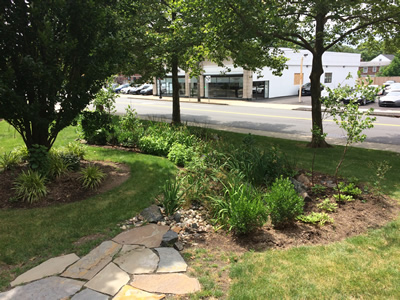Rain Gardens
Summit City Hall
512 Springfield Avenue, Summit, Union County, New Jersey 07901
| Google (TM) Map | Site Contact(s) | History | Runoff Managed |
| Installation | Plant Layout | Maintenance | Photographs |
Sara Mellor, Rutgers Cooperative Extension Water Resources Program
The Summit City Hall rain garden was installed to capture, treat, and infiltrate stormwater runoff from a portion of City Hall’s roof via two redirected downspouts.
The potential to install a rain garden at Summit City Hall was identified through site assessments that were conducted as part of a grant the Rutgers Cooperative Extension (RCE) Water Resources Program received: “National Fish and Wildlife Foundation ~ Incorporating Green Infrastructure Resiliency in the Raritan River Basin.” A deliverable for the grant included visiting 54 towns within the Raritan River Basin and identifying locations where green infrastructure could be installed.
The rain garden was designed by Tobiah Horton, Assistant Extension Specialist in Landscape Architecture. The Summit Environmental Commission supported the project, and the Department of Community Services was instrumental in having the site excavated. The location of the rain garden is ideal to demonstrate to local residents how a rain garden can enhance their property.
This rain garden manages stormwater runoff from a portion of the City Hall's roof through two downspouts which were disconnected and redirected to the rain garden.
This rain gardens was installed in June 2016 by Tobiah Horton and the RCE Water Resources Program staff and interns. An excavator was used by a subcontractor, paid for by the City of Summit, to dig out the rain garden. The sod was removed from the rain garden footprint, and the native soil was removed. Approximately 27 tons of bioretention soil was added to the base of the rain garden to promote infiltration. Next a three-inch layer of shredded hardwood mulch was added to thwart weeds and retain moisture, leaving a six-inch open ponding area. The inlets were made by disconnecting the downspouts from the storm sewer system. Two trenches were dug in which PVC pipe was laid, and fittings were added to connect the PVC pipe to the existing downspouts. The trenches are sloped at an angle to allow the runoff from the downspouts to enter the rain garden. The native plants used in this rain garden were installed under the direction of Tobiah Horton, the RCE Water Resources Program staff, and interns. The plants were purchased from Plant Detectives, Pinelands Nursery & Supply, and New Moon Nursery.
Funding for this project is provided by the Department of the Interior through a grant from the National Fish and Wildlife Foundation’s Hurricane Sandy Coastal Resiliency Competitive Grant Program.
Plant
Layout:
Rain
Garden Map:
Click here for the Summit City Hall design plan
Rain Garden Parameters:
Rain garden size - 700 square feet (annual runoff volume captured - 72,955 gallons)
Drainage area - 1,620 square feet
Plant List:
Blue Flag Iris
Blue Mistflower
Cardinal Flower
Cinnamon Fern
False Solomon’s Seal
Jack-in-the-Pulpit
Marginal Wood Fern
Red Columbine
River Birch
Soft Rush
Swamp Azalea
This rain garden is currently maintained by the RCE Water Resources Program.
Click here for photographs of the Summit City Hall rain garden.
